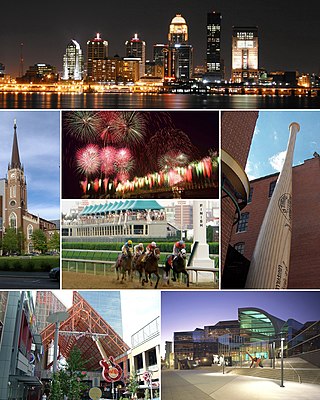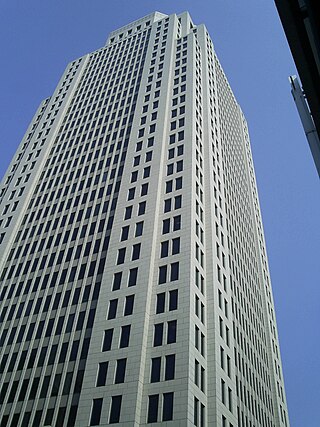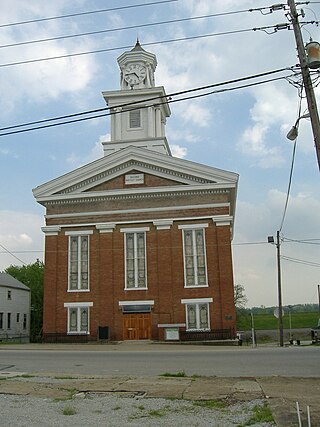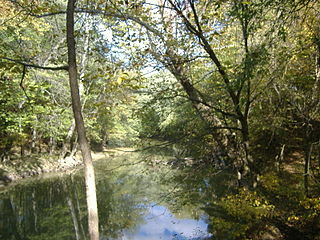
Louisville is the largest city in the Commonwealth of Kentucky and the 28th most-populous city in the United States. Louisville is the historical seat and, since 2003, the nominal seat of Jefferson County, on the Indiana border.

Clark County is a county in the U.S. state of Indiana, located directly across the Ohio River from Louisville, Kentucky. At the 2020 census, the population was 121,093. The county seat is Jeffersonville. Clark County is part of the Louisville/Jefferson County, KY–IN Metropolitan Statistical Area.

Clarksville is a town in Clark County, Indiana, United States, along the Ohio River and is a part of the Louisville Metropolitan area. The population was 22,333 at the 2020 census. The town was founded in 1783 by early resident George Rogers Clark at the only seasonal rapids on the entire Ohio River, it is the oldest American town in the former Northwest Territory. The town is home to the Colgate clock, one of the largest clocks in the world and the Falls of the Ohio State Park, home to the world's largest exposed Devonian period fossil bed.

Madison is a city in and the county seat of Jefferson County, Indiana, United States, along the Ohio River. As of the 2010 United States Census its population was 11,967. Over 55,000 people live within 15 miles (24 km) of downtown Madison. Madison is the largest city along the Ohio River between Louisville and Cincinnati. Madison is one of the core cities of the Louisville-Elizabethtown-Madison metroplex, an area with a population of approximately 1.5 million. In 2006, the majority of Madison's downtown area was designated a National Historic Landmark—133 blocks of the downtown area is known as the Madison Historic Landmark District.

Colgate-Palmolive Company is an American multinational consumer products company headquartered on Park Avenue in Midtown Manhattan, New York City. The company specializes in the production, distribution, and provision of household, health care, personal care, and veterinary products.

Portland is a neighborhood and former independent town northwest of downtown Louisville, Kentucky. It is situated along a bend of the Ohio River just below the Falls of the Ohio, where the river curves to the north and then to the south, thus placing Portland at the northern tip of urban Louisville. In its early days it was the largest of the six major settlements at the falls, the others being Shippingport and Louisville in Kentucky and New Albany, Clarksville, and Jeffersonville on the Indiana side. Its modern boundaries are the Ohio River along the northwest, north, and northeast, 10th Street at the far east, Market Street on the south, and the Shawnee Golf Course at the far west.

Downtown Louisville is the largest central business district in the Commonwealth of Kentucky and the urban hub of the Louisville, Kentucky Metropolitan Area. Its boundaries are the Ohio River to the north, Hancock Street to the east, York and Jacob Streets to the south, and 9th Street to the west. As of 2015, the population of Downtown Louisville was 4,700, although this does not include directly surrounding areas such as Old Louisville, Butchertown, NuLu, and Phoenix Hill.

Falls of the Ohio State Park is a state park in the U.S. state of Indiana. It is located on the banks of the Ohio River at Clarksville, Indiana, across from Louisville, Kentucky. The park is part of the Falls of the Ohio National Wildlife Conservation Area. The exposed fossil beds of the Jeffersonville Limestone dated from the Devonian period are the main feature of the park, attracting about 160,000 visitors annually. The Falls was the site where Lewis and Clark met for the Lewis and Clark Expedition at George Rogers Clark's cabin.

The Colgate Clock is an octagonal clock facing the Hudson River near Exchange Place in Jersey City, New Jersey. The clock has a diameter of 50 feet (15 m). It was located atop of what was once the headquarters of the Colgate-Palmolive, until 1985, when was moved to a ground-level location 1,300 feet (400 m) south of that building, which was demolished and replaced with the Goldman Sachs Tower.

The Palmolive Building, formerly the Playboy Building, is a 37-story Art Deco building at 919 N. Michigan Avenue in Chicago. Built by Holabird & Root, it was completed in 1929 and was home to the Colgate-Palmolive-Peet Corporation.

The Fourteenth Street Bridge, also known as the Ohio Falls Bridge, Pennsylvania Railroad Bridge, Conrail Railroad Bridge or Louisville and Indiana (L&I) Bridge, is a truss drawbridge that spans the Ohio River, between Louisville, Kentucky and Clarksville, Indiana.

Fourteen Mile Creek, shown as Fourteenmile Creek on federal maps, is a 22.7-mile-long (36.5 km) creek in Clark County, Indiana, close to Charlestown. It is so named because its mouth on the Ohio River is 14 miles (23 km) upstream from the Falls of the Ohio; similar to how Eighteen Mile Island, Twelve Mile Island, and Six Mile Island got their names. It is navigable for 2.9 miles (4.7 km) from the Ohio River. It is a State Heritage Program Site and a popular canoe trail.

Green Tree Mall is an shopping mall located in Clarksville, Indiana, United States. The mall is located off of I-65 about four miles (6 km) north of downtown Louisville. It has a total area of 795,382 square feet (73,893 m2). It was named for a large boundary tree of considerable age that once stood at the location. Currently, there are more than 80 inline stores and 2 major anchor stores. The third anchor was Sears which closed on October 1, 2017. The mall is managed by Centennial Realty. Green Tree Mall is a retail anchor for the Clarksville area.

The Town Clock Church, now the Second Baptist Church of New Albany, Indiana, United States, is a historic church located at 300 East Main Street, within the New Albany Downtown Historic District. It was constructed in 1852 as Second Presbyterian Church, in what was then the largest city in Indiana. It is near the Ohio River, across the border from Louisville, Kentucky.

Mayor Andrew Broaddus is a lifesaving station built by the United States Life-Saving Service located in Louisville, Kentucky, off the corner of River Road and Fourth Street. She is named in honor of Andrew Broaddus (1900-1972), a former mayor of Louisville (1953-1957). Her historic purpose was to protect travelers on the Ohio River from the Falls of the Ohio, with rescue crews for those who fell victim to the rapids. Louisville was the first place where a lifesaving station was placed in western waters. The first lifestation in Louisville was in 1881, with Mayor Andrew Broaddus as the third. A National Historic Landmark, she is the only surviving floating lifesaving station of the US Life-Saving Service.

Camp Joe Holt was a Union base during the American Civil War in Jeffersonville, Indiana, across the Ohio River from Louisville, Kentucky, on land that is now part of Clarksville, Indiana, near the Big Eddy. It was a major staging area for troops in the Western Theatre of the War, in preparation for invading the Confederate States of America. Its establishment was the first major step performed by Kentucky Unionists to keep Kentucky from seceding to the Confederacy.

Silver Creek is a stream in southern Indiana in the United States. It drains a watershed of 97,442 acres (394.33 km2). The creek rises in Scott County and flows 38.0 miles (61.2 km), dropping 168 feet (51 m), before flowing into the Ohio River.
Colgate Clock may refer to:

About 60% of Kentucky lies in the Eastern Time Zone, with the rest in the Central Time Zone, as follows:


















